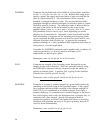
POINT Adds a linearly-polarized point electric dipole source at the given
position. Point sources whose polarization is not x, y, or z
(diagonally, circularly, or elliptically polarized) can be implemented
as two or three point sources with appropriately chosen magnitude
and phase.
Parameters: x y z Ex Ey Ez mag phase
3.1.7. COMMAND Group
COMPUTE Supply control parameters to FIDO/TEMPEST. Parameters mincycles
and maxcycles control the number of cycles of the excitation
frequency that each simulation may use; setting the lower limit
occasionally helps in avoiding spurious early convergence, and the
upper puts a bound on the amount of run time. Adjusting
maxcycles to a small number such as 1-3 is useful when setting up a
run, because you can get rapid feedback on whether your geometry
is correct, and whether your PMLs are likely to cause problems.
Slightly higher values are useful in the early stages of an
optimization, where extreme accuracy in penalty function evaluation
is not needed, but run time is a serious concern. See the TEMPEST
documentation for more details. Start with a value of 0.01 or 0.001
for reltolerance, and don’t set mincycles or timestep until you really
need to.
Parameters: reltolerance maxcycles mincycles timestep
3.1.8. OUTPUT Group
INDEXN Tells tempest to produce a field file containing the real part of the
refractive index at each point. This is useful to show which
material is where in the simulation domain.
Parameters: xlo xhi ylo yhi zlo zhi file
DECIMATE Specify that only 1 out of decimation points is to be kept in each axis.
Parameters: xdecimation ydecimation zdecimation
Not implemented in this release.
22


















